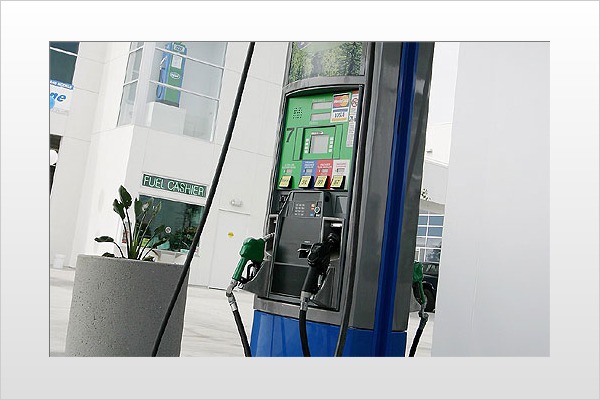
For more information on alternative fuel vehicles, click here.
Special to Edmunds.com from Green Car Journal
As we've witnessed during the 1990s and these first few years of the 21st century, alternative fuel vehicles of many types can fill important roles in niche, and sometimes mass, markets.
Certainly, there is a sizable commercial following for compressed natural gas vehicles, particularly among fleet operators whose vehicles are driven on predictable local or regional routes that lend themselves to centralized refueling. Vehicles running on liquid propane gas (LPG) are also popular in the business community.
A bevy of other fuels have found their way to the highway over the years ranging from methanol, a fuel that's largely come and gone, to biodiesel, which is just now beginning to gather momentum.
Nowhere is the potential for alternative fuels so clearly evident as with the ethanol flexible-fuel vehicles being sold in truly significant numbers each year by major automakers. Vehicles ranging from the Chevy Suburban and Ford Taurus to the Dodge Caravan and Mazda B3000 offer flexible-fuel gasoline/E85 ethanol capability as a matter of course.
The nearly three million E85 FFVs now on our highways could be making at least a small impact on imported oil consumption if only they were driving on renewable ethanol-based fuel. Largely, they are not because fewer than 200 E85 stations exist in the U.S. The challenge, of course, is to create a business case for establishing an E85 ethanol fueling infrastructure, as well as the political will to make it happen.
Automakers are beginning to work toward improving this situation. One recent effort is a public awareness program that aims to increase E85 use in flexible-fuel vehicles that are currently running on gasoline. Conducted by GM and the National Ethanol Vehicle Coalition, the two-year campaign is focusing on Colorado, Michigan, Minnesota, Missouri and Wisconsin. Here, owners of GM flexible-fuel vehicles are receiving a $40 debit card that can be used to purchase E85 fuel, a list of E85 fueling stations in their area and literature about E85 ethanol.
Encouragement comes in other forms as well. For instance, the use of price breaks at the pump goes a long way toward motivating drivers to fill up with an alternative fuel. Illinois has become the first state in the nation to eliminate sales tax for E85, bringing its cost about 10 to 14 cents per gallon below that of regular gasoline.
Sometimes an end run is needed for success, while other times a bold step forward is what it takes. Here, it's appropriate to point to Honda's efforts as it prepares to introduce its natural gas Honda's Civic GX to new car showrooms later this year. The GX has proven itself a worthy fleet vehicle over the past five years, and now Honda is taking the bold step of marketing this alternative fuel vehicle to consumers…with a twist. Available with the Civic GX is a home refueling unit called "Phill," a fueling appliance priced under $2,000 that allows a GX owner to conveniently refuel his vehicle overnight at home.
While this refueling method may work for natural gas vehicles since most homes have natural gas service, not all alternative fuels are this convenient. Infrastructure development remains a critical component in making alternative fuel vehicles a long-term success.
Amidst the slow progression toward widespread alternative fuel use, there are some bright spots. One of these is the Regional Transportation Center (RTC) in San Diego, Calif., which features a one-of-a-kind fuel depot that aims to handle the needs of both conventional and alternative fuel vehicles. This facility offers compressed natural gas, LPG, ethanol E85, biodiesel and electricity, along with three standard grades of gasoline and low-sulfur diesel fuel for flexible-fuel and conventional vehicles.
Fuels are dispensed from eight-foot-tall, futuristic-looking Eclipse pumps by white-gloved attendants at no additional charge. The RTC facility is open seven days a week and accepts all major credit and debit cards, as well as cash. An alternative fuel vehicle showroom, AFV rental/demo center and AFV repair facility are also on-site to make this a full-service facility.
Clearly, if the auto industry and government agencies wish to make a statement that alternative fuels and the vehicles that run on them are to be an integral part of our future, this is the way to do it. Here's hoping that others look at RTC as an example of how to create a pathway to bringing alternative fuels to the mass market.
ALTERNATIVE FUEL VEHICLES
Most alternative fuel vehicles from the major automakers today are primarily marketed to fleets, although they are generally available to anyone wishing to buy one in most, but not all, states. Keep in mind that many of them are offered as alternative fuel models only with a single specific engine. The following are some examples of vehicles available with flex-fuel options today.
Chevrolet SuburbanChevrolet TahoeFord ExplorerFord Explorer Sport TracGMC Yukon XL Mercury Mountaineer
Copyright Green Car Journal. All rights reserved.